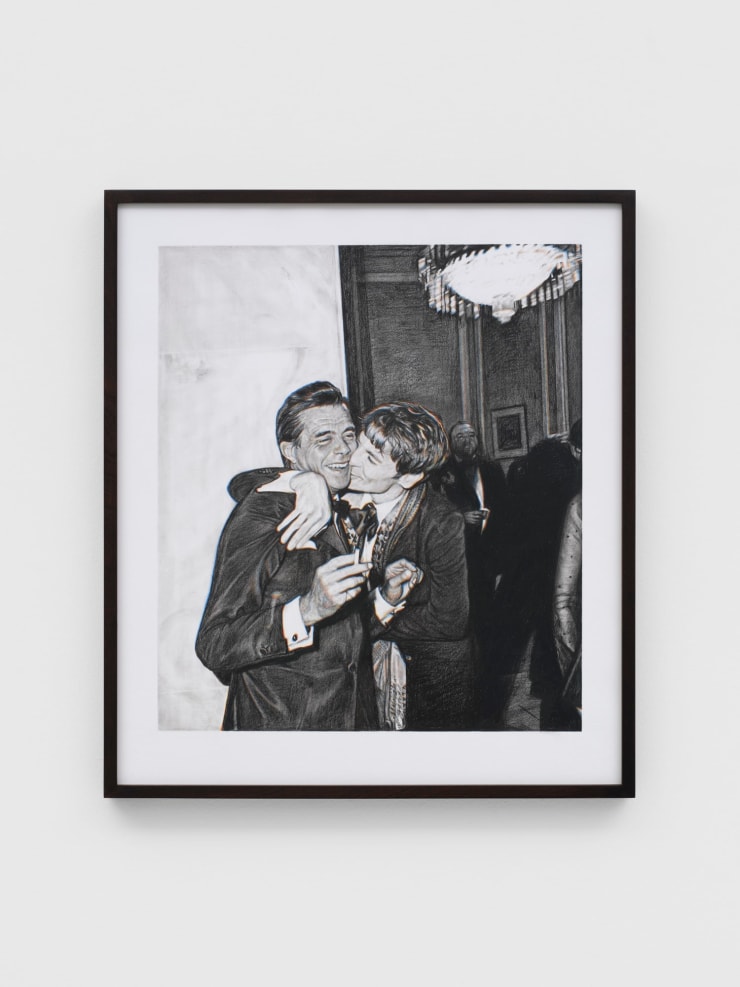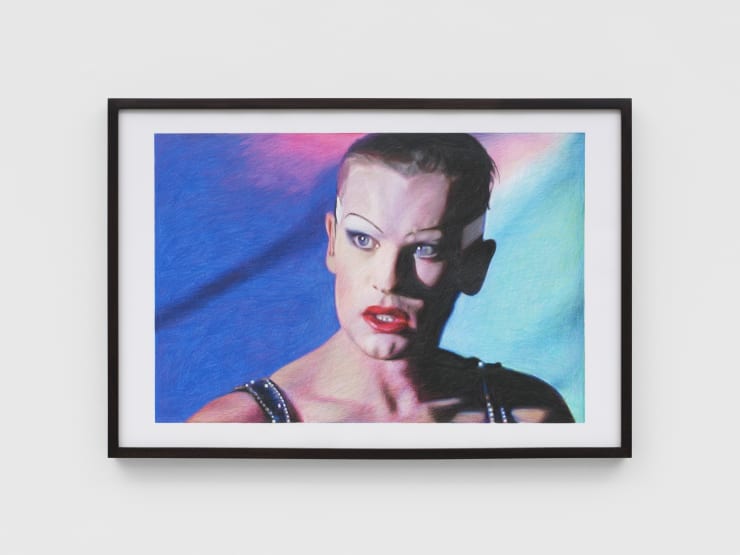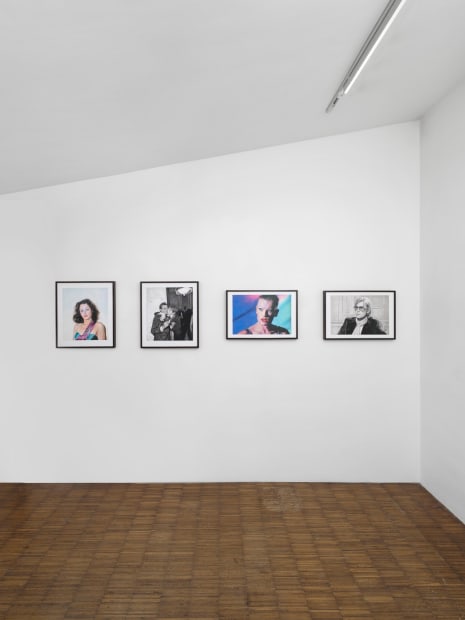-

-
Cob presents Snails and Oysters - a suite of four new drawings by Nina Mae Fowler. The exhibition is accompanied with a text by Harry Tafoya - Arts editor at-large at Paper Magazine.These works are the combined result of the artist’s forensic research methods, her personal fandom and an instinctive creative process - where found images linger in her studio until they resonate with one another and then are transformed into drawings. It is arguable that the subjects of these four drawings are brought together for the ambiguities and the conflicts that arose between their private lives and public personas - the former deemed unorthodox by society at the time of their fame. Meanwhile, this new series sees the artist experimenting further in the coloured pencil medium.The series title Snails and Oysters refers to a scene between Laurence Olivier and Tony Curtis that was controversially cut from Stanley Kubrick’s Spartacus for nearly 30 years owing to its reference to bisexuality. What had been, in 1960, a brave attempt by scriptwriter Dalton Trumbo to reflect the nuances of Greek and Roman attitudes to same-sex love and intimacy is now a straightforward depiction of homosexuality. The National Legion of Decency— which was a front for the Catholic Church —had vetoed the scene, and it fluttered to the cutting room floor.The inspiration for this series began with the passing of Helmut Berger in May 2023 - an actor previously unknown to Fowler. Berger was the lover of Italian filmmaker Luchino Visconti; a renowned hedonist and known for his portrayal of narcissistic and sexually ambiguous characters. Three of the four drawings in this series depict Berger - one image is taken from a televised interview, whilst another vibrant coloured drawing depicts him in his breakthrough role in Visconti’s The Damned (1969) - where his character impersonates a Marlene Dietrich-like cabaret singer. As Fowler’s research intensified, she discovered an image of the actor Dirk Bogarde and Berger embracing at a party which forms the third image- Bogarde also a star of Visconti’s films. Here, Fowler draws a parallel between these men - that being their defiance of mainstream norms and bold approach to filmmaking. Meanwhile, both Berger and Bogarde hid their sexuality from view to maintain their box office appeal. As Fowler creates her drawings, she builds new connections which seek to clarify the artworks purpose in her mind - here Fowler honed in on a contrast between Helmut Berger's disinterest in his own fame and the emotional depth of his character in The Damned that mirrored the complexities of his life.With Fowler always seeking to push the boundaries of the drawing medium, the two seemingly monochromatic drawings in the series see Fowler apply a new technique where subtle colour is injected around the edges of the highlights and lowlights, creating a pulsating effect across the drawing.Here, the artist is emulating an effect called ‘moiré fringes, which is caused by the interference patterns that arise when two regular textures with similar but slightly different frequencies or orientations overlap or interact. The colours subtly infused into the drawings could be viewed as a glitch or patch of noise, disrupting convention and expectation - just like the subjects themselves.The fourth drawing depicts the Golden Age cinema actress Hedy Lamarr. Reminiscent of a Warhol polaroid, the drawing is taken from a very unusual coloured photograph of Lamarr slightly dishevelled and in costume for her role in Samson and Delilah (1949). Fowler returns to Lamarr as a subject - a renowned beauty - considered to be the most beautiful woman in the world at one stage - but overlooked as an extraordinary inventor (she in fact invented the technology that underpins bluetooth and WiFi). Fowler describes her connection with this image as “she looks like a woman who is so impossibly tired of her face being used. Slightly sweaty, bruised. She was decades ahead of her time and her looks overshadowed one of the most remarkable inventive brains of the 20th century. Consistently underestimated during her lifetime - I feel you can see this behind her eyes here.”
-
-
-
Crassus: Do you consider the eating of oysters to be moral and the eating of snails to be immoral?
Antoninus: No, Master.
Crassus: Of course not. It is all a matter of taste isn’t it? And taste is not the same as appetite and therefore not a question of morals, is it?
It’s a thing of beauty to behold, Laurence Olivier (Crassus) in Spartacus (1960) using moral philosophy to tease out whether an oiled-up, half-naked Tony Curtis (Antoninus) might be a little bit bi. The euphemism here is exquisite and achieves such a potent, matter-of-fact dose of camp that you almost wonder what stopped Olivier from going the extra mile and making perverse little motions with his tongue. Taken against the broader backdrop of brazen Hollywood innuendo, it’s not nearly as graphic or outrageous as some of the sex jokes, sight gags, or half-obscured nudity that actually made it to the screen. What is striking however is the blatant moral inversion, which would have been unmistakable to the righteous maniacs charged with censoring it. In a few lusty words, Crassus lays out a decidedly un-Christian ethos, where delectation is a virtue but hunger is a vice; where one is free to binge on beautiful surfaces but longing for substance is viewed as a mark of perversion. All of which is to say, he presents the value system of Ancient Rome as not being terribly far removed from Old Hollywood’s.
In her latest show, Snails and Oysters, Nina Mae Fowler navigates between appetite and hunger, tracing the fault lines where manicured celebrity persona gives way to smoldering chasms of emotional need. Traditionally, a movie star’s sleight of hand was to seduce the public with beauty, wealth, and accomplishment, blinding the masses with their exceptionalism, so that they’d appear beyond wanting for anything. Psychology was held to be the enemy of glamour and everyone from the studio bosses to gossip columnists agreed that wrinkles in a star’s perfection would only make it more difficult for the public to project onto them. Any hint of an actor’s private anguish, destructive compulsion, or unspoken longing was glossed over in banality, left on the cutting room floor, or buried beneath layers of subtext for a discerning viewer to excavate.
Fowler is the ideal audience. She is a sensitive reader of movie stars as big-screen ciphers, as taken by their outsized myth as she is attuned to the subtle, jagged emotions that flicker across their lovely features. Her mission as an artist is to return depth to dazzle, judging her subjects at face value from disarming and off-kilter angles. She is a fan of Frank Auerbach’s maxim: “drawings offer us experiences of what it feels like to engage deeply with another person,” and her own engagement is sympathetic but complicated; both unsparing and forgiving of how ravenous, pathetic, and all-around human their desires truly are.
The moments that Fowler pulls inspiration from are interstitial, caught between frames, when an unwitting look or a sudden trick of the light reveals the conflicted thoughts waging war in a movie star’s beautiful head. Her practice is research-heavy but not overly-academic, in pursuit of emotional truth rather than period correctness. She is lovingly disrespectful of an actor’s sense of vanity, drawing them sweaty, disheveled, or grimacing; when their surface is at its most obviously troubled.
For Helmut Berger and Hedy Lamarr there was much to trouble. Both actors were impossibly and inconveniently beautiful. In different eras each found themselves in the position of being presented to the world as the faces (and bodies) of uninhibited European sexuality. At 18, Lamarr debuted in Ecstasy (1933), which featured extensive nudity and depicted the first-ever orgasm onscreen. When Hollywood snapped her up, she left behind an abusive marriage for an alienating one, opening a psychic rift between her person and persona that never fully healed. Small things (a habit of speaking in third person, being baffled why anyone would want her autograph) snowballed into alarming behavior later in life (abandoning her son, reclusion, only ever wanting to engage the world through her phone).
In “Snails and Oysters (Hedy)” (2024), Lamarr is depicted behind the scenes of Samson and Delillah (1949), her most successful Hollywood production. In Fowler’s rendering, she is beautiful but dissociated, her body is present but her brilliant, listless mind is miles away. The vacancy of her stare is enhanced by the blinding front-facing light, which gives the image the same head-on focus that one typically associates with Warhol polaroids. But where the glamour of Warhol’s work was of encountering completely self-possessed freaks, the horror of Fowler’s work derives from coming upon a fundamentally lost and fragmented self. Fowler further emphasizes Lamarr’s beauty and disorientation through her technique as a draughtsman, layering similar but subtly off textures that give the impression that the woman before us is shifting out of focus in real time.
Helmut Berger had a similarly split notion of himself as an actor and a human being. His creative and romantic partnership with the director, Luchino Visconti bore out brilliantly brutal collaborations that indulged in hedonism and violence, for which Berger was regularly cast as his completely amoral prince charming. In Snails and Oysters, Fowler captures Berger between roles: ill at ease in a TV interview and half-in-drag in the opening of The Damned (1969). Like his contemporary, the socialite Jacques de Bascher, Berger staked “his life on glamour and its implicit promise of a life devoid of mediocrity” and the effect was of a terribly superficial existence incapable of admitting weakness or pain. In both of Fowler’s drawings, Berger is further stripped of his costume and left to flounder as himself in the spotlight, unsure of who he is or what he might do.
The show’s most tender piece is “Snails and Oysters (Dirk and Helmut)” (2024). Working from a photograph of a loving embrace between Berger and his Damned co-star, Dirk Bogarde, Fowler not only depicts a moment of overwhelming joy but also charts an alternate path for what Berger’s life could have been. Bogarde, whose name even sounds similar, was a gay film star who began his career as a matinee idol before charting a much more iconoclastic path as an actor. He was closeted but not stifled, and possessed a unique talent for modulating between gentile manners, breathtaking vulnerability, and flare-ups of bottomless cruelty. He was somebody who’d made peace with his competing drives, and like Fowler and her exquisite drawings, ultimately turned them into art.
Harry Tafoya is an art and music writer. He is currently the Arts Editor at-large for PAPER Magazine and has previously published in Frieze, NPR, Pitchfork, Art in America, and more.”
-

Nina Mae Fowler: Snails and Oysters
past viewing_room







